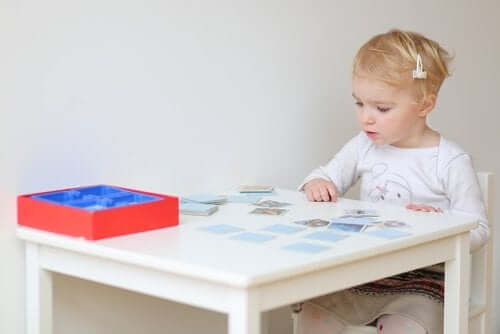8 Ways to Strengthen Working Memory


Written and verified by the psychologist Mara Amor López
Sometimes, children have a hard time retaining information for a short period of time. Because of that, it’s important to strengthen working memory. This type of memory is responsible for storing and working with the information that’s stored in our short-term memory.
A few years ago, people also referred to working memory as “short-term memory.” Today, people use both terms because they have to do with people’s executive function. Keep reading to learn more about the different ways to strengthen working memory.
How to strengthen working memory in children
When it comes to learning, children use their working memory the most. This memory is necessary when it comes to following directions or if they need to take certain steps to solve a math problem mentally.
Parents can use different strategies to help strengthen working memory in their children. Let’s take a look at some of those strategies.

Strengthen working memory while encouraging reading
A good strategy to help reinforce working memory in school-aged children is to have them underline the text they’re studying or reading. This will help them retain the information they’ve read for a longer period of time. Then, they’ll be able to answer any questions they have about what they’ve just read. Another thing they can do is read the passage aloud as they study. In addition, you can ask them questions about what they’ve read.
Divide the information into small parts
It’s always easier to retain small groups of numbers than a long row. Why do you think you remember your phone number and ID better than your bank account number? It’s because those numbers are separated by dashes or spaces, whereas your bank account number is a long continuous number.
Therefore, when you’re giving your child instructions, you should do it step-by-step or one-by-one. If you’re trying to divide a written task into smaller parts, you can have your child use a graphic organizer to help them.
Play card games
Card games help strengthen working memory in two ways:
- Children have to remember the rules of the game
- They need to remember which cards they have and which ones the rest of the players have played
Multi-sensory information
It’s important to provide the information to your child in various ways. For example, write down the things they have to do and put the notes on the fridge. That way, they’ll have to read them to know what tasks they need to do.
In addition, you can also tell them the tasks out loud so they can hear them. This will help them retain the information better and they’ll remember it later on when they need to use it.
Create connections to help strengthen working memory
By creating connections between different things, you’re making the information easier to remember. For example, you and your child can work to create mnemonic devices. To help them remember several words, they can take the first letter of each word to create a word that’s easy to remember.
Finding a way to connect the information to other things helps children recover long-term memory as well as working memory. As a result, they can retain the new information and connect it with their old memories.

Ask your little one to teach you
Another strategy you can use is to ask your child to explain something to you that they’re learning to do. Being able to explain what they’re learning shows that your child has understood the information and can store it mentally.
Play games the require visual memory
One of the best games your child can play to work on their visual memory is the game Memory. In this game, they try to find matching pairs by flipping two cards over with images on the back. If they don’t find a match, they flip the cards back over and try again. This game helps strengthen working memory because your little one has to remember where each image is for a short period of time so they can find its match.
In addition, you can also play another game in which you give your child a magazine and ask them to find and circle certain words or letters.
Work with visualization skills
Encouraging your child to create pictures of what they read or hear will help them remember the information better. You can ask them to create a story while they read or while you read to them. Also, you can ask them to draw a picture after you finish the story. By doing that, they will eventually be able to describe the details without having to draw them.
Conclusion
In this article, we’ve discussed different strategies that can help you strengthen working memory in your child. It’s important to stimulate their working memory so they can increase their ability to retain short-term information. Children often have a hard time retaining information for a short period of time, but these ideas will help. What are you waiting for? Start putting them into practice!
Sometimes, children have a hard time retaining information for a short period of time. Because of that, it’s important to strengthen working memory. This type of memory is responsible for storing and working with the information that’s stored in our short-term memory.
A few years ago, people also referred to working memory as “short-term memory.” Today, people use both terms because they have to do with people’s executive function. Keep reading to learn more about the different ways to strengthen working memory.
How to strengthen working memory in children
When it comes to learning, children use their working memory the most. This memory is necessary when it comes to following directions or if they need to take certain steps to solve a math problem mentally.
Parents can use different strategies to help strengthen working memory in their children. Let’s take a look at some of those strategies.

Strengthen working memory while encouraging reading
A good strategy to help reinforce working memory in school-aged children is to have them underline the text they’re studying or reading. This will help them retain the information they’ve read for a longer period of time. Then, they’ll be able to answer any questions they have about what they’ve just read. Another thing they can do is read the passage aloud as they study. In addition, you can ask them questions about what they’ve read.
Divide the information into small parts
It’s always easier to retain small groups of numbers than a long row. Why do you think you remember your phone number and ID better than your bank account number? It’s because those numbers are separated by dashes or spaces, whereas your bank account number is a long continuous number.
Therefore, when you’re giving your child instructions, you should do it step-by-step or one-by-one. If you’re trying to divide a written task into smaller parts, you can have your child use a graphic organizer to help them.
Play card games
Card games help strengthen working memory in two ways:
- Children have to remember the rules of the game
- They need to remember which cards they have and which ones the rest of the players have played
Multi-sensory information
It’s important to provide the information to your child in various ways. For example, write down the things they have to do and put the notes on the fridge. That way, they’ll have to read them to know what tasks they need to do.
In addition, you can also tell them the tasks out loud so they can hear them. This will help them retain the information better and they’ll remember it later on when they need to use it.
Create connections to help strengthen working memory
By creating connections between different things, you’re making the information easier to remember. For example, you and your child can work to create mnemonic devices. To help them remember several words, they can take the first letter of each word to create a word that’s easy to remember.
Finding a way to connect the information to other things helps children recover long-term memory as well as working memory. As a result, they can retain the new information and connect it with their old memories.

Ask your little one to teach you
Another strategy you can use is to ask your child to explain something to you that they’re learning to do. Being able to explain what they’re learning shows that your child has understood the information and can store it mentally.
Play games the require visual memory
One of the best games your child can play to work on their visual memory is the game Memory. In this game, they try to find matching pairs by flipping two cards over with images on the back. If they don’t find a match, they flip the cards back over and try again. This game helps strengthen working memory because your little one has to remember where each image is for a short period of time so they can find its match.
In addition, you can also play another game in which you give your child a magazine and ask them to find and circle certain words or letters.
Work with visualization skills
Encouraging your child to create pictures of what they read or hear will help them remember the information better. You can ask them to create a story while they read or while you read to them. Also, you can ask them to draw a picture after you finish the story. By doing that, they will eventually be able to describe the details without having to draw them.
Conclusion
In this article, we’ve discussed different strategies that can help you strengthen working memory in your child. It’s important to stimulate their working memory so they can increase their ability to retain short-term information. Children often have a hard time retaining information for a short period of time, but these ideas will help. What are you waiting for? Start putting them into practice!
This text is provided for informational purposes only and does not replace consultation with a professional. If in doubt, consult your specialist.








